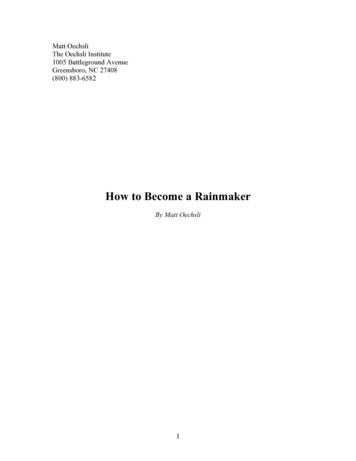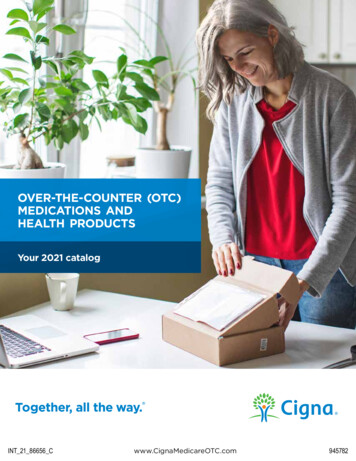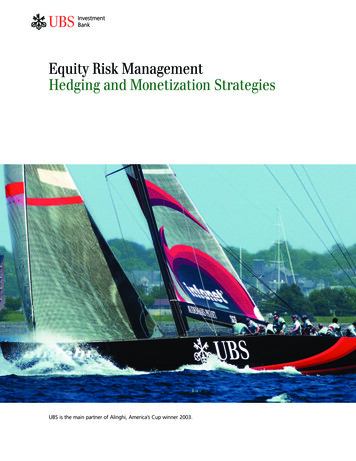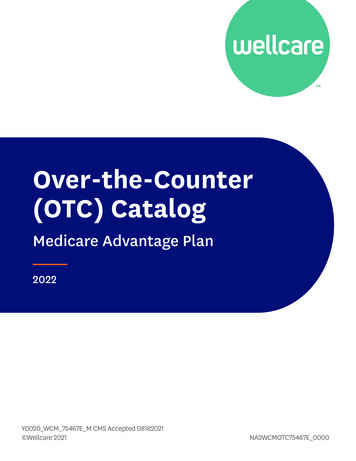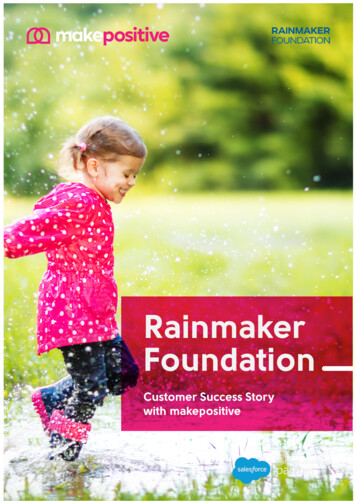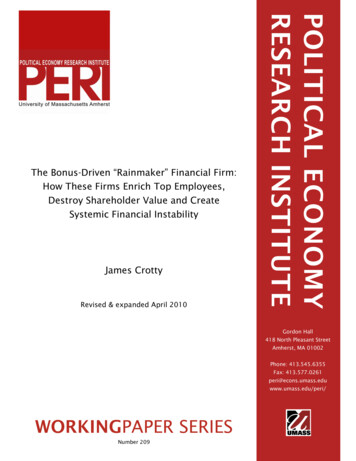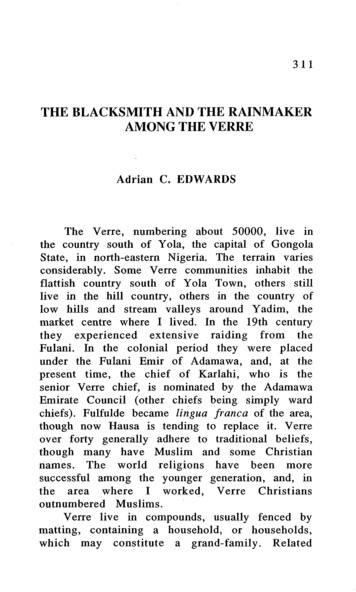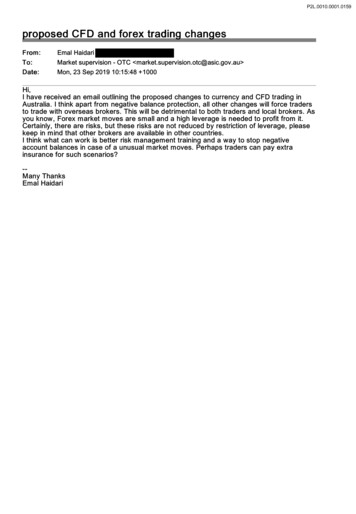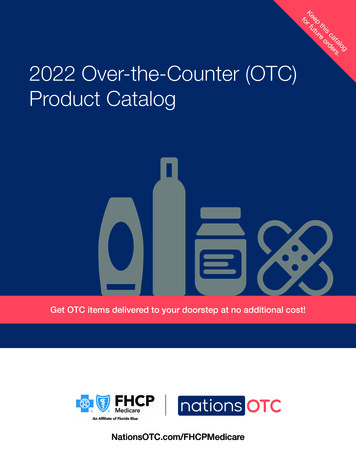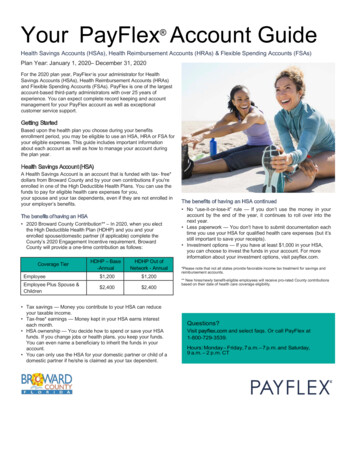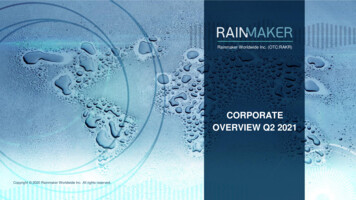
Transcription
Rainmaker Worldwide Inc. (OTC:RAKR)CORPORATEOVERVIEW Q2 2021Copyright 2020 Rainmaker Worldwide Inc. All rights reserved.
Safe Harbor StatementThis presentation contains forward-looking statements which may constitute “forward-looking statements” within the meaning of the Securities Act of 1933 and the SecuritiesExchange Act of 1934, as amended by the Private Securities Litigation Reform Act of 1995. The forward-looking statements involve known and unknown risks, uncertainties and otherfactors which may cause our actual results, performance or achievements to be materially different from any future results, performances or achievements expressed or implied by theforward-looking statements.Forward-looking statements include statements about: our estimates of product sales, future costs and expenses, revenue and profitability; trends affecting the price of water; trendsaffecting our financial condition and results of operations; our ability to attract and retain customers or achieve our targeted customer capacity; the availability and terms of capitalfinancing; our ability to deliver our products on schedule; development of new product initiatives to enhance our brand; industry trends and the competitive environment; the impact oflosing one or more senior executive and/or failing to attract additional key personnel; and other factors referenced in this document. In some cases, you can identify forward-lookingstatements by terms such as “anticipates,” “believes,” “could,” “estimates,” “expects,” “intends,” “may,” “plans,” “potential,” “predicts,” “projects,” “should,” “will,” “would,” and similarexpressions intended to identify forward-looking statements. Forward looking statements reflect our current views with respect to future events are based on assumptions and aresubject to risks and uncertainties. Given these uncertainties, you should not place undue reliance on these forward-looking statements.Also, forward-looking statements represent our estimates and assumptions only as of the date of this document. You should read this document and the documents that we referencecompletely and with the understanding that our actual future results may be materially different from what we expect. Additional factors that may cause actual results to differ fromthose anticipated are discussed throughout the Company’s Annual Report filed May 2020, with Securities and Exchange Commission and should be reviewed and consideredcarefully as well as the Company’s other reports filed with the United States Securities and Exchange Commission and are available at https://www.otcmarkets.com/stock/RAKR/ aswell as the Company’s web site at http://www.rainmakerww.com. You are cautioned not to place undue reliance on these forward-looking statements, which speak only as of the dateof this presentation. All forward-looking statements are qualified in their entirety by this cautionary statement. The Company undertakes no obligation to update or revise forwardlooking statements to reflect changed assumptions, the occurrence of unanticipated events or changes to future operating results. No securities regulatory authority has expressed anopinion about Rainmakers’ securities and it is an offense to claim otherwise. This document does not constitute a public offering of Rainmaker securities. Last updated October 2020.
Who is Rainmaker?Rainmaker is helping to solve the global water crisisby delivering economical, scalable and environmentallysustainable Water-as-a-Service solutions using innovativetechnology and a dynamic partnership business model.
The World’s Water SupplyLess than 3% of the world’s water is fresh – therest is seawater and undrinkable in its currentstate.Of this 3% over 2.5% is frozen and locked up inAntarctica, the Arctic and glaciers.People and animals rely on 0.5% of the world’swater.Source: Unwater.org - Facts and Trends: Water“At any moment, the atmosphere contains37.5 million billion gallons of water.”Source: Gleick, P. H., 1996: Water resources. In Encyclopedia of Climate and Weather, ed. byS. H. Schneider, Oxford University Press, New York, vol. 2, pp. 817-823.
Why Focus on Water?“50 liters of water per person/day required for most basic needs”World Health Organization It is estimated that by 2030 nearly half of humanity will be living in severe water stress1 2.2 billion people around the globe lack safe drinking water 2 On average, high-income countries only treat 70% of wastewater, low-income countriestreat 8% 3 39% groundwater depletion rate is unsustainable 4 The world’s population is growing, projected to become 9 billion by 2038 5 # 6 of UN’s 17 Sustainable Development Goals1Source: OECD (2008), OECD Environmental Outlook to 2030, OECD Publishing, Paris. Retrieved from: https://doi.org/10.1787/9789264040519-enSource: United Nations Children’s Fund (UNICEF) and World Health Organization (WHO). (2019). Progress on household drinking water, sanitation and hygiene 2000-2017. Special focus on inequalities. [PDF file].Retrieved from g-water-sanitation-hygiene-2019/3 Source: UNESCO: The United Nations World Water Development Report 2017. Wastewater: The Untapped Resource. UNESCO 2017. d-resource/4 Source: Citi GPS: Global Perspectives & Solutions. (2017). Solutions for the global water crisis:The end of ‘free and cheap’ water [PDF file]. Retrieved from bal-water-crisis/5 Worldometers, elaboration of data by United Nations, Department of Economic and Social Affairs,Population Division.2
The Global Water Crisis Requires a Global Business ModelUneven distribution of water ficantmicro-gapmarkets belowthe surface1Source:ResourceIndustriesCiti GPS: Global Perspectives & Solutions. (2017). Solutions for the global water crisis:The end of ‘free and cheap’ water [PDF file]. solutions-global-water-crisis/Macro crisis centered aroundhighest global growth regions
The Global Water CrisisAlthough the global water supply remains fixed,consumption is increasing.Source: Allianz Global Investors (2017, July 20). 5 Reasons to go active withwater investing. Retrieved from: nvestingSource: OECD (2008), OECD Environmental Outlook to 2030, OECDPublishing, Paris. Retrieved from: https://doi.org/10.1787/9789264040519-en
Giant Total Addressable Market 7.5-10 Trillion required to maintain, upgrade and build global water infrastructure3Rainmaker solutions address 70% of 620 billion global market today;estimated to grow toThe Global Water Market: 620 billion1 1 TRILLIONBY 202512Source: UBS (2019, May 09). Longer term investments: Water scarcity [PDF file].Retrieved from ericas/cio-impact/water%20scarcity.pdf2 Source: RobecoSAM Study (2015, June). Water: the market of the future [PDF file].Retrieved f907694f044ed76ecfbf63a2 robecosam-water-study tcm1011-14997.pdf3 Source: Citi GPS: Global Perspectives & Solutions. (2017). Solutions for the global water crisis:The end of ‘free and cheap’water [PDF file]. Retrieved from bal-water-crisis/
Our ThesisA massive entrenched industry ripe for disruption.A global problem that requires disruption to solve.
RainmakerWater-as-a-Service Scalable and cost-effective solutions Wide-use case applications Global partner model Sustainable, social and environmentallyprogressive Proprietary technology and developmentpipeline
Water Supply — Ways to Create Clean Drinking WaterTraditionalEmerging / DisruptiveWells: This is dependent on reaching the water table and finding a substantialquantity of drinkable water. Groundwater depletion levels are significant.Convert air humidity to water: We extract and condense moisture in the air toproduce healthy, purified drinking water with our Air-to-Water application.Rainwater: Viable and sustainable collection system designed to gather rainwaterthroughout the year; however, many regions have substantial dry seasons andcurrent global infrastructure requires significant update.Next generation treatments: We can inexpensively transform a much higherproportion of undrinkable, contaminated and saline water into safe, clean waterthrough our next generation Water-to-Water application.Desalination: Utilizes plentiful seawater, but extremely expensive for distributedwater solutions and has a high level of feed water wastage and negativeenvironmental factors.Rainmaker Air-to-WaterLarge-scale infrastructure CAPEX Usually requires stable power gridRainmaker Water-to-WaterScalable, networked OPEX solutions Energy agnostic, optimized for renewables
Air-to-Water (AW) Through our Air-to-Water application, we harvest water bycombining atmospheric humidity, heat and air flow. Produces 5,000, 10,000 or 20,000 liters per unit, per day.Water-to-Water (WW) Through our Water-to-Water application, we transformcontaminated water (saltwater, sewage, polluted) into safe,clean water. Produces 37,500, 75,000 or 150,000 per unit, per day.
Modern, Efficient andSustainable Solutions Portable, networked and distributed solutions. Rapiddeployment and repositioning. Energy agnostic, renewable power optimized.Provides wide flexibility in remote situations. Chemical free, no filter design Distributed footprint, flexible feed source and uniquevariable flow-through optimization limitsenvironmental impact Innovative membrane distilation and heat wasteoptimization designs Proprietary air flow and energy optimizationalgorithms
Rainmaker’s Competitive Business Model:Water-as-a-Service — Built to ScaleJoint Venture Partnerships provide local access, project deployment and channel expertiseCONTRACT JV’S for particular use cases structured as 5-10 year off-take agreements.Typically 75% ownership.COMMERCIAL JV’S targeting particular geographies or industries. Typically 50-75%ownership.Solutions provided through 3 main modular, networked and scalable product deployments:Air-to-Water solutions where scarcity, mobility and flexibility are critical. Typically competing againsthigh cost trucking or infrastructure solutions.Water-to-Water solutions to address desalination, water treatment and mineral isolationopportunities. Flexible feed source application. Cost competitive with traditional RO and wastetreatment options with significantly lower investment.Hybrid AW and WW deployments to provide integrated drinking and non-drinking water closedloop systems.
Addressing all geographies and cationDriven by AmbientTemperature / RelativeHumidity MixDriven by Access toSeawater, Polluted Wateror Grey Water Reuse1Source:Citi GPS: Global Perspectives & Solutions. (2017). Solutions for the global water crisis:The endof ‘free and cheap’ water [PDF file]. Retrieved from balwater-crisis/
Breadth of Global Applications and Use Case ChannelsInstitutionalCommercial and Industrial Geographic utility opportunities withinadequate water supply or infrastructure: Healthcare and Hospital applications Real Estate Development and TourismIslandnations, remote communities,TRUCKED / Middle East, 0.05 - 0.18100,000Africa,SEAsiaRAIN COLLECTEDPER LITERLITERSSweet spot: 500-50,000 person networkeddeployments Agriculture Resource Extraction Food and Beverage Municipal applications in developed countrieswhere aging infrastructure impacts access towater quality 1,930,000 1,250,000 Industrial / Factory Applications Excess renewable energy monetization Military applications By-product sales – salt, minerals, etc Government Agencies, NGO’s, CSR programs,Emergency Preparedness
Highly Scalable and Profitable Recurring Revenue ModelMODULAR AND SCALABLE equipment and WaaS sale eliminates upfrontcustomer CAPEX and shortens sales and deployment cycleRAPID, TURNKEY DEPLOYMENT with minimal infrastructure requirementsModest and demand-scaled capital intensity allows for ATTRACTIVEPROJECT FINANCING and access to subsidesInitial PROOF OF CONCEPT DEPLOYMENTS scale exponentiallyHIGH CASH MARGINS and low operating costs create compelling economicsfor Rainmaker and JV partners.Typically deployment payback 1 yearCOST COMPETITIVE with traditional alternatives with lower investment andmore flexibility
Daily Unit Run-Rate EconomicsWater-to-WaterAir-to-WaterLiters Produced / Day:4,500Liters Produced / Day:35,000Floor Price / Liter: 0.10Floor Price / Liter: 0.05Revenue / Day ( ): 450Revenue / Day ( ): 1,750Gross Margin 75%: 1,313Start-up/Allocated Expenses 20%: 350TRUCKED100,000 338/Gross Margin75%:RAIN COLLECTEDLITERS 90Start-up/Allocated Expenses 20%: 0.05 - 0.18PER LITEREBITDA: 248 (55%)EBITDA: 963 (55%)Target Production Cost: 50,000Target Production Cost: 250,000EBITDA Payback Period:6.7 MonthsEBITDA Payback Period:8.5 Months5-year Cash Return: 379,1885-year Cash Return: 1,306,875Investment @ 60% LTV: 20,000Investment @ 60% LTV: 80,000Unit ROI:19 xUnit ROI:17 xTypical JV Ownership:49-80%Multi-year Off-takeMerchant Projects49-75%
RAKR (OTC) Restructuring
Key Updates in Q1 2021i.Audited Financials for 2018-2020 made publicii.Elimination of 6,250,000 in debtiii.Restructuring of Dutch Entity eliminating R&D costsiv.20M shares returned to RAKR from Dutch Entityv.Favorable product purchase agreements that ensurelong term profitabilityvi.Retention of 12% interest in Dutch Entityvii.Retain one of two seats on management board ofDutch Entity
Management TeamMichael O’ConnorChairman and CEOJoost OosterlingManaging DirectorRainmaker Holland B.V.Joost DessingChief Technology OfficerKelly WhiteVice PresidentOperations & Finance
Investor Contact:investors@rainmakerww.com
Appendix
Unique Operating Advantages of Rainmaker’s Air-to-Water Unique Sweet Spot of 500-50,000 population networkedcommunities. COST per liter of water is lowest in the category. Designrequires minimal maintenance and operational expenditure. CAPACITY: Produce more liters of water per day than mostcompetitors under the same climatic and energy conditions. CHOICE OF INSTALLATION SIZES WITH NETWORKEDSCALABILITY: Four of our AW- GO25 machines will fit in a40-foot container CHOICE OF POWER SOURCES: Wind, solar, grid or generator.Optimized for remote renewable energy operations. SET-UP TIME: Deployment as fast as 90 daysWe are in the scale business. We do not compete in the marketsfor household-size units.
APPENDIX: Robust WW Product DevelopmentRainmaker Worldwide Inc. Wins EU Horizon 2020 ProjectDutch military conducts extensive testing Rainmaker technology for mission-critical deployments Two-year process of due diligence by the EuropeanUnion 2.5 million to develop 4 Water-to-Water solutionprototypes in the Canary Islands. Testing will be across grid, solar, wind and hybridenergy sources, including the only desalination of itskinds powered 100% by renewable energy. Over a three-year period starting in September 2019,the program will build, install and validate thetechnology. Initial production capacity will be 80,000 liters per day. Membrane Distillation Water/Power Unit – Based onmilitary specs and Bredenoord’s state-of-the-artmilitary-grade generator Fieldlab Smartbase 1.0 project: Next gen tech forMission-Critical forward military bases, emergencyresponse and disaster relief. Containerized solution designed for transport by ISOstandard freight trucks. Each unit can provide up to 20,000 liters of puredrinking water and 30 kW of electricity daily under allconditions; without any power grid connection. Disruptive platform to displace high cost and lessflexible transport and/or reverse osmosis (RO)solutions
APPENDIX: Unique Attributes of Rainmaker’s Membrane DistillationWater-to-Water TechnologyOperating Advantages:Environmental / Efficiency Advantages: Lower operating temperatures required compared to Renewable energy source optimized (solar, wind,conventional distillation. Operates at feed temperaturesconsiderably lower than the boiling point of water. Lower operating hydrostatic pressures than thepressure-driven RO processes. Generally nearatmospheric pressure. Compact process size that is scalable. Material flexibility reduces cost and avoids corrosionproblems. Unique differentiation vs current market solutions atscale less than 500m3/day.hybrid). More water production by volume of water input thanalternatives. 100% rejection of ions, macromolecules, colloids,biological cells and other non-volatile impurities. Capable of treating feed water with highconcentrations of pollutants or salt concentrationnear saturation point. No brine disposal necessary; zero liquid waste is possible. No highly toxic anti-fouling chemicals are necessary.
APPENDIX: Water-to-Water DesalinationEnvironmental Impacts of Large-Scale SeaWater Reverse Osmosis (SWRO)High volume concentrated facilities either independent ofDistributed, Networked Solutions with Continuous Flowor co-located with a power production facility.Rate FlexibilityIntakes: Depending on the complexity of the feedwaterIntakes: On a small to medium scale RWI WW operatesand marine biology, the large volumes of feedwater canat a 90/10 ratio versus RO at 50/50 therefore requiringhave significant negative impacts on marine lifefar less feedwater, far less energy (especially with(impingement and entrainment).renewable) and no impact on the localized marineOutfall: Returning highly concentrated brine together withenvironment.toxic cleaning chemicals to a local marine environmentOutfall: Limited brine per liter of feedwater allows forcan cause significant damage.alternative post-treatment options. RWI WW technologyOperating Inefficiencies: In complex SWRO solutions, anddoes not produce volumes of brine that impact thein general, energy inefficiency will create a significantmarine environment.localized environmental impact. RO is highly energyOperating Inefficiencies: No chemicals, no carbonintensive representing 40% of total OPEX.footprint (with renewable energy) and limited O and Mreduces environmental impact per liter significantly.
APPENDIX: Rainmaker Water-as-a-Service Platform Wide-Use Case ApplicationsModular, portable, distributed solutions rapid turnkey deployment & repositioningFlexible, networked applications – industry, commercial, humanitarian, militaryEnergy Agnostic, Renewable power optimized — provides wide flexibility Scalable and Cost-Effective SolutionsCost competitive at attractive margin & payback economicsCapital efficient, flexible, low variable cost customer applicationsNot reliant on local infrastructure — flexible footprint Sustainable, Social and Environmentally ProgressiveChemical free, no-filter designDistributed footprint and unique variable flow-through optimizationDual technologies address most impacted humanitarian and health situations Proprietary Technology and Development PipelineInnovative membrane distillation & heat waste optimization designsProven technologies combined with flow & energy optimization algorithms
APPENDIX: Core Patents Supporting RWI ProductsSystem and method for purification of water bymembrane distillation:WATER PRODUCTION UNIT1.1433.0001 WO, PCT/NL2020/050223 Registeredin the Netherlands and following the PCT route toregister internationally.AW application membrane separates watercondensation area from ambient air.Countries:Turbine Rotor driven compressorAU - 2009309685 (pending)PCT/EP2009/060734EP - 09744137.2 (pending)IN - 1777/KOLNP/2011 (pending)Equal use of several power conversionUS - 12/998,321 (pending)units in turbine.Countries:AU - 2009286785 (pending RFE filed)TowerBR - PI0917179-7 (pending)CN - 200980142780.0 (pending)Rotating tower supported on centralEP - 09782002.1 (pending RFE filed)bearing and held upright by a support ring.IN - 750/KOLNP/2011 (pending)MA - PV/33631 (pending RFE filed)US - 12/737,848 (pending)ZA - 2011/01484 (granted 26/10/2011;expires 19/08/2029)
APPENDIX: Guidelines and StandardsThe following guidelines and certifications are followed by Rainmaker in the assembly andimplementation of our Air-to-Water and Water-to-Water solutions: Guidelines for drinking-water quality (GDWQ) –World Health Organization (WHO), 4th edition, 2017EU Drinking Water Directive(Council Directive 98/83/EC of 3 November 1998)NSF/ANSI 42NSF/ANSI 53NSF/ANSI 44NSF/ANSI 55NSF/ANSI 62NSF/ANSI 244NSF/ANSI 401CE, CSA and UL
Product and Technology RoadmapAir-to-WaterWater-to-Waterv 2.0 Product in Deployment Phase1.5 in Deployment Phase Q2: Complete field testing – on-site and remotediagnostics in Jamaica, Morocco and Sri Lanka Q4 2021 Deliver on EU sponsored 2.3Mshowcase grant in Canary Islands Q3LITERS2021: Lock final vRAIN2.0 designoutsourcing andPER LITERCOLLECTEDscalable production Deploy initial field prototypes in Canada and NAfrica in Q4 2021 2022: v2 prototype will 50% better water productionefficiency Q4 2021 finalize quick deployment version By 2023: Run rate unit cost @50% of deploymentunits via sourcing and design strategy2022: v2 with enhanced thermal and renewableenergy efficiencyTRUCKED /100,000 1,930,000 0.05 - 0.18 1,250,000Systematic and robust technology development to date IP based on 10 years of underlying technology developmentStrong connections with key Dutch and Canadian research institutes
Nov 03, 1998 · Who is Rainmaker? Rainmaker is helping to solve the global water crisis by delivering economical, scalable and environmentally sustainable Water-as-a-Service solutions using innova
